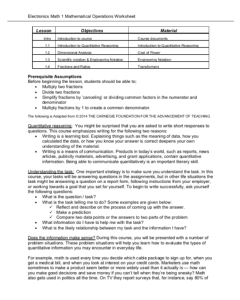Mathematical Operations

This mathematical operations lesson, from the Contextualize to Learn project at the University of Wisconsin - Madison, is part of a series of seven applied electronics math lessons. This lesson applies simple mathematics for complicated situations and simple circuit terminology is introduced. It is important for each student to be able to clearly sketch, label, and explain simple DC resistive circuits. Sketching a circuit is a good engineering practice and if done well, communicates concepts and ideas effectively. The math in this lesson covers basic arithmetic, fractions, ratios, percentages, calculating percentage change, using dimensional analysis to find unit rates and convert metric and engineering notation. The lesson also works with bits and bytes, and introduces turns ratio for transformers and how that connects with Voltage.
Two PDF's are included, an 11-page student lesson and a 12-page instructor guide with notes and answers. The expected total time for the lesson is five hours.
About this Resource

Comments